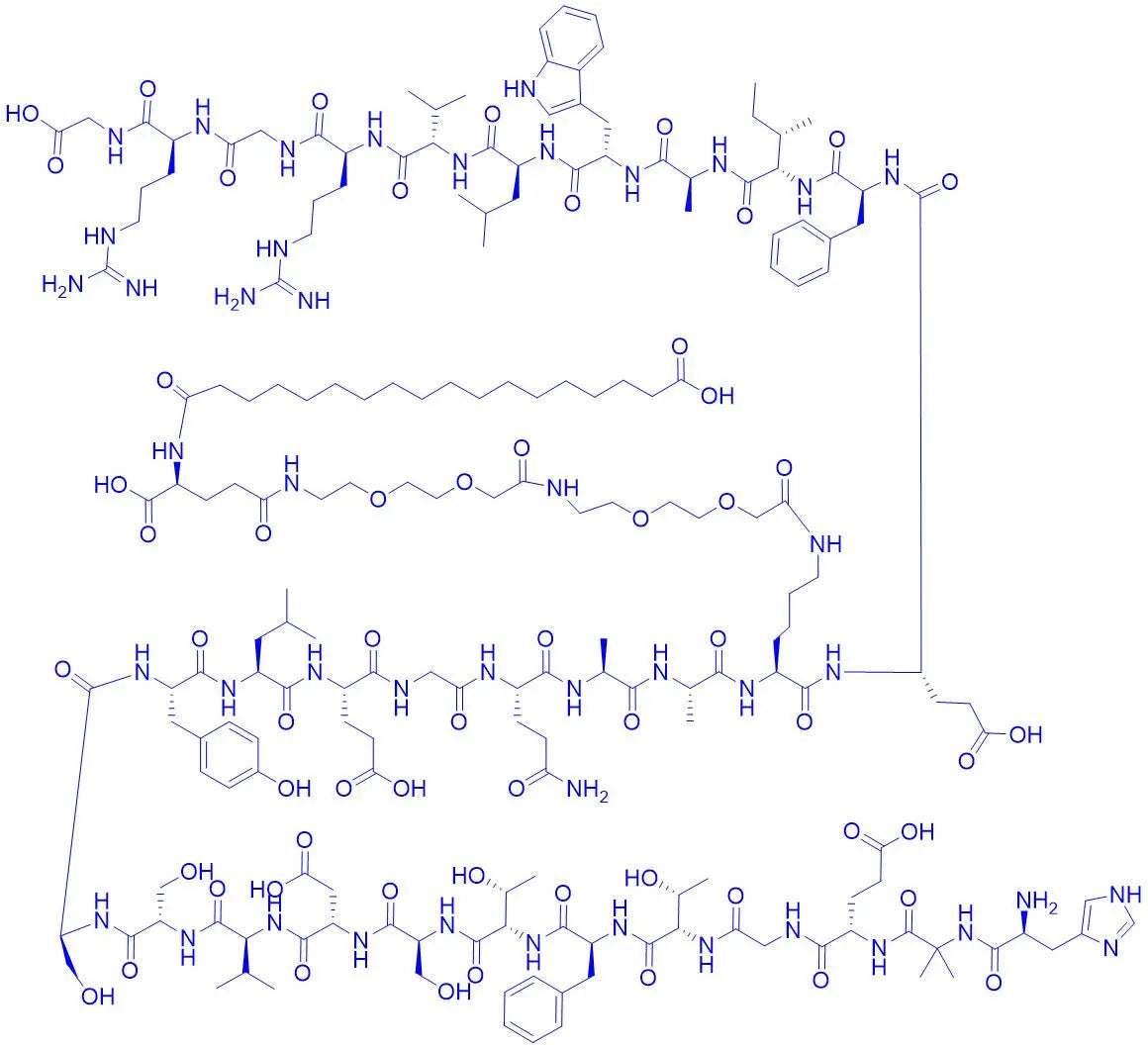
A Researcher's Guide to Semaglutide: A Tool for In Vitro Metabolic Research
Semaglutide
The glucagon-like peptide-1 (GLP-1) receptor is a class B G-protein-coupled receptor that has become a major focus of metabolic research. Its role in cellular pathways makes it a key target for investigation in endocrinology and neurobiology labs. To study this receptor with precision, scientists rely on stable, potent, and highly specific agonists. Semaglutide is a powerful chemical tool designed for this exact purpose.
This article will provide a technical overview of Semaglutide, focusing on its biochemical structure, its mechanism of action as a GLP-1 receptor agonist, and its applications in a laboratory setting. All information is presented for an audience of qualified researchers, in line with the "Research Use Only" (RUO) designation for this compound.
Biochemical Profile of Semaglutide
Semaglutide is a chemically modified analogue of human GLP-1. Specific structural modifications were engineered to increase its stability and resistance to enzymatic degradation by dipeptidyl peptidase-4 (DPP-4), a common challenge when working with native GLP-1 in vitro. As a semaglutide synthetic peptide, its design confers a long half-life and high binding affinity for its target. The key modifications include an amino acid substitution at position 8 and the attachment of a fatty diacid chain via a spacer to the lysine at position 26 (Lau et al., 2015).
-
Molecular Formula: C₁₈₇H₂₉₁N₄₅O₅₉
-
Molecular Weight: 4113.6 g/mol
-
CAS Number: 910463-68-2
Mechanism of Action for In Vitro Investigation
In a laboratory context, Semaglutide functions as a highly selective agonist for the GLP-1 receptor (GLP-1R). When applied to cell cultures expressing GLP-1R (such as pancreatic, neuronal, or engineered cell lines), it mimics the action of endogenous GLP-1, initiating a downstream signaling cascade. This process typically involves the activation of adenylyl cyclase and a subsequent increase in intracellular cyclic AMP (cAMP) levels.
This precise mechanism makes semaglutide research peptides invaluable for studying the direct cellular effects of sustained GLP-1R activation, allowing researchers to isolate and investigate specific biological questions without the rapid degradation seen with the native peptide.
Applications in a Laboratory Setting
The use of Semaglutide in a research setting is focused on fundamental discovery and cellular analysis. Its stability and potency make it a superior tool for a variety of in vitro experiments conducted in semaglutide research labs. Common applications include:
-
Studying Insulin Secretion Pathways: Researchers apply Semaglutide to cultured pancreatic islet cells (e.g., INS-1 or MIN6 cell lines) to investigate the molecular mechanisms of glucose-stimulated insulin secretion in a controlled environment.
-
Neurobiology Research: In cultured neuronal cells, Semaglutide is used to explore the role of GLP-1R signaling in cellular survival, differentiation, and neuroinflammatory pathways (Hosking et al., 2023).
-
Receptor Function and Pharmacology: It serves as a reference agonist for screening new compounds, for comparative analysis of receptor binding kinetics, and for studying receptor desensitization and internalization phenomena in vitro.
Handling and Storage of Lyophilized Semaglutide
To ensure reproducibility and maintain the integrity of the compound, proper handling is essential. The lyophilized semaglutide format provides maximum stability for shipping and long-term storage and should be kept in a freezer at or below -20°C. Before use, the powder must be reconstituted in a suitable sterile solvent. Due to its chemical nature, it is recommended to consult technical datasheets for the most appropriate reconstitution buffer. Once in solution, it should be stored refrigerated for short-term use or aliquoted and frozen for long-term storage to prevent degradation.
Conclusion
Semaglutide is a sophisticated and highly valuable research tool for the in vitro study of the GLP-1 receptor and its associated metabolic and cellular pathways. Its enhanced stability and potent agonist activity allow for controlled, reproducible experiments that would be difficult to achieve with native GLP-1.
For any laboratory experiment, the quality of the reagents is paramount. Using a high-purity research chemical semaglutide that has been independently verified is the only way to ensure that the observed experimental outcomes are valid and publishable.
Sources:
-
National Center for Biotechnology Information (2025). PubChem Compound Summary for CID 56843331, Semaglutide. Retrieved July 14, 2025 from https://pubchem.ncbi.nlm.nih.gov/compound/Semaglutide.
-
Lau, J., Bloch, P., Schäffer, L., Pettersson, I., Wulff, B. S., & Kofoed, J. (2015). Discovery of the Once-Weekly Glucagon-Like Peptide-1 (GLP-1) Analogue Semaglutide. Journal of Medicinal Chemistry, 58(18), 7370–7380.
-
Hosking, J. A., et al. (2023). GLP-1 analogues as a potential therapeutic for motor neuron disease. Heliyon, 9(4), e14999.
Disclaimer
All products available on this website are sold for laboratory research and in vitro purposes only. They are not for use in humans or animals and are not intended for any therapeutic or diagnostic application. By purchasing from Mindful Research, the customer acknowledges the known and unknown risks associated with the handling and use of these chemical compounds and confirms they are a qualified professional (e.g., a researcher, scientist, or technician) who will use these products in a properly equipped facility in accordance with all applicable laws and regulations.
The statements made within this website have not been evaluated by the US Food and Drug Administration. The statements and the products of this company are not intended to diagnose, treat, cure or prevent any disease.
Mindful Research is a chemical supplier. Mindful Research is not a compounding pharmacy or chemical compounding facility as defined under 503A of the Federal Food, Drug, and Cosmetic act. Mindful Research is not an outsourcing facility as defined under 503B of the Federal Food, Drug, and Cosmetic act.
